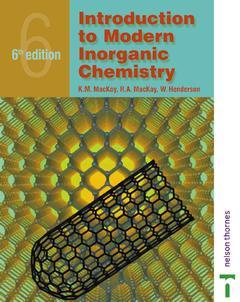Introduction to Modern Inorganic Chemistry, 6th edition (6th Ed.)

This popular and comprehensive textbook provides all the basic information on inorganic chemistry that undergraduates need to know. For this sixth edition, the contents have undergone a complete revision to reflect progress in areas of research, new and modified techniques and their applications, and use of software packages.
Introduction to Modern Inorganic Chemistry begins by explaining the electronic structure and properties of atoms, then describes the principles of bonding in diatomic and polyatomic covalent molecules, the solid state, and solution chemistry. Further on in the book, the general properties of the periodic table are studied along with specific elements and groups such as hydrogen, the 's' elements, the lanthanides, the actinides, the transition metals, and the "p" block. Simple and advanced examples are mixed throughout to increase the depth of students' understanding.
This edition has a completely new layout including revised artwork, case study boxes, technical notes, and examples. All of the problems have been revised and extended and include notes to assist with approaches and solutions. It is an excellent tool to help students see how inorganic chemistry applies to medicine, the environment, and biological topics.
INTRODUCTION; Inorganic Chemistry and the Discovery of the Elements; Development; Recent Advances; Inorganic Nomenclature; Approach to Inorganic Chemistry and Further Reading; Problems; THE ELECTRONIC STRUCTURE AND THE PROPERTIES OF ATOMS; Introduction; Theory of the Electronic Structure of Hydrogen; Many-electron Atoms; Shapes of Atomic Orbitals; Further Properties of the Elements; ; COVALENT MOLECULES; DIATOMICS; General Background; Diatomic Molecules; ; POLYATOMIC COVALENT MOLECULES; Introduction; The Shapes of Molecules and Ions Containing p Bonds Only; The Shapes of Species Containing p Bonds; General Approaches to Bonding in Polyatomic Species; Bonding in Polyatomics; The Two-centre Bond Approach; Two-centred Orbitals; Hybridisation; Delocalized, or Multi-centred, s Orbitals; p Bonding in Polyatomic Molecules; An Example of the Approach Using Delocalized Bonding Throughout; Extension to Other Molecules; Problems; ; THE SOLID STATE; Simple Ionic Crystals; The Formation of Ionic Compounds; The Born-Haber Cycle; The Lattice Energy; The Endothermic Terms in the Formation of an Ionic Solid; Bonding Which is not Purely Ionic; Metallic Bonding; Complex Ions; The Crystal Structures of Covalent Compounds; Defect Structures and Nonstoichiometric Solids; Problems; ; SOLUTION CHEMISTRY; Aqueous Solutions; Solubility; Acids and Bases; Oxidation and Reduction; Nonaqueous Solvents; Solubility and Solvent Interaction in Nonaqueous Solvents; Acid-base Behaviour in Nonaqueous Solvents; General Uses of Nonaqueous Solvents; Liquid Ammonia; Anhydrous Acetic Acid; 'Superacid' Media; Bromine Trifluoride; Supercritical Fluids; Problems; ; EXPERIMENTAL METHODS; Separation Methods;
Date de parution : 11-2002
21x27.9 cm
Date de parution : 06-2017
21x28 cm
Thèmes d’Introduction to Modern Inorganic Chemistry, 6th edition :
Mots-clés :
Transition Metals; oxidation; Main Group; states; Main Group Elements; lone; Transition Elements; pair; Trigonal Bipyramid; trigonal; Main Group Chemistry; bipyramid; Oxidation State; pentagonal; Inorganic Chemistry; square; Lone Pairs; pyramid; American Chemical Society; mol; Atomic Orbitals; Kj Mol; Energy Level Diagram; Boron Neutron Capture Therapy; Iv State; Lower Oxidation States; Group Oxidation State; Bioinorganic Chemistry; Lanthanide Elements; Molecular Orbitals; Vi State; Organometallic Chemistry; Octahedral Complexes; Antibonding Orbital; Ionization Potentials



